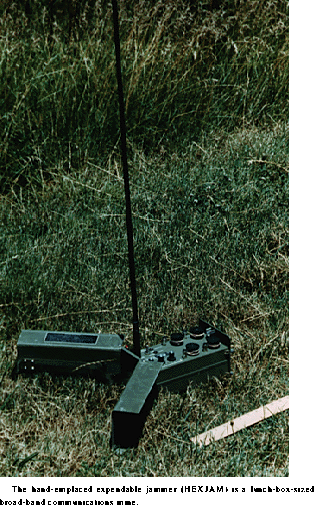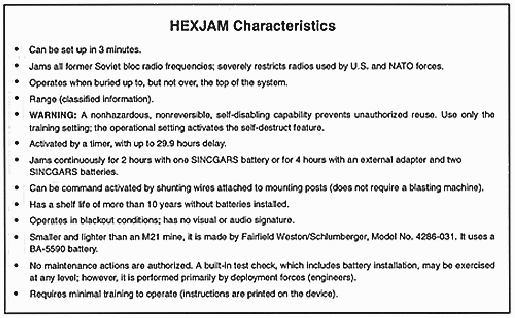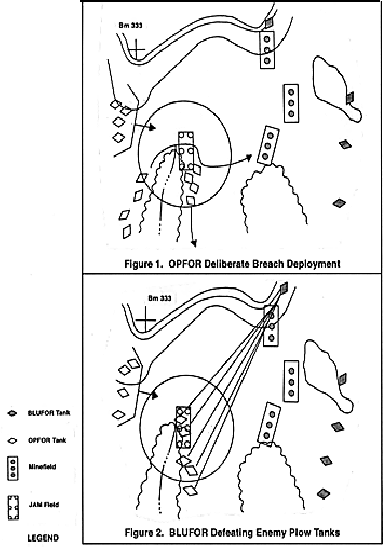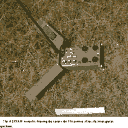
By Captain Dale A. Kornuta and First Lieutenant Brian R. Dunmire
History

Obstacles in the electromagnetic spectrum (such as radios; microwaves; global positioning system receivers; and laser, visual, and thermal sights) must be part of the ground that we shape. We engineers must not restrict ourselves to destroying vehicles and personnel but concentrate on achieving the commander's intent. Disrupting the enemy's command and control slows or desynchronizes his maneuver, thereby supporting the killing systems of the task force. Disrupting the enemy's motorized rifle company or battalion while it conducts breaching operations can have a ripple effect reaching all the way up to regimental headquarters. Such disruptions may force him to commit follow-on forces early to make up for the forces destroyed in the breach.

If the enemy's direction-finding systems find the jammers, they can only report that fact, because the standard opposing force (OPFOR) tactic is to use heavy artillery or rocket launchers to destroy jammers. His problem now is that the jammers are "in the wire" with his forces.
The HEXJAM's small size and delayed activation make it a flexible munition. Its disrupting effect is truly nondiscriminatory, affecting engineer, artillery, and maneuver personnel. Engineers in the breach-or one terrain feature short of the obstacle-lose their communications. Forward observers supporting the breach experience disruptions. The assault force awaiting the breach and the support-by-fire team that never gets the call to mass or shift fires are also affected.
When the enemy is in the defense, HEXJAMs pushed forward with the scouts isolate security forces, thereby disrupting the entire enemy security zone.
Action. Company/team lanes were conducted in the 1-kilometer-wide avenue of approach south of Bench Mark 333 (Figure 1). The ground the maneuver commander chose for his defense was bound by a steep, wooded mesa on the north and forested, low ground on the south. The jam field was placed forward of the main defensive belt in the low ground and covered by the keyhole tank on the extreme north of the main defensive position.

The OPFOR tank company maneuvered to conduct a deliberate breach. The support force deployed on the intervisibility line south of Bench Mark 333 and established a support-by-fire position. The jam field was activated using the time-delay function, which allowed the engineers to clear the battlefield before the direct-fire engagement.
The support force skirted the low, vegetated ground in the south and the OPFOR commander moved with his breach force of four plow tanks into an attack position within the jam field. The attack stalled for 10 minutes while the OPFOR commander attempted to regain communication with his platoons. In the absence of orders, the security force worked the low ground to the south, off the map and out of the battle. The blue force (BLUEFOR) keyhole tank then annihilated all the plow tanks in a short, one-sided fire fight (Figure 2). Eventually, based on the platoon leader's understanding of the commander's intent, the security force conducted a desynchronized platoon attack (Figure 3).

Effects. The OPFOR commander and plow tanks were effectively removed from the fight, desynchronizing the attack. The commander never realized he was being jammed because he maintained constant communication with his wing tank even though he lost communication with all of his platoons. The security force passed through the jam field with little effect, because it was not assigned a critical mission at the location of the jam field. The jam field was covered with fires, allowing it to produce the maximum effect.
Action. During Task Force Lane's offensive operations, scouts from the 3-67 Armored Battalion, Fort Hood, placed HEXJAMs near vacant enemy fighting positions before the positions were occupied. With less than 10 minutes of instruction, the scouts effectively employed the HEXJAMs. The devices were activated using the time-delay function based on line of departure plus movement time.
Effects. Tank commanders were observed dismounting to develop hasty hand and arm signals, which became their only means of communication during the battle. Lacking radio communications, the tanks could not coordinate direct fires. Their higher headquarters could not effectively control them nor could they carry out the plan for indirect fires, since they could not hear their fire support officer. This led to destruction of the tanks and desynchronization of the OPFOR defensive fight.
Communications minefields will require special rules of engagement or obstacle restrictions, such as in observer/controller locations. Its short operational time requires excellent intelligence on the enemy time line or command detonation. The batteries required for the HEXJAM must be requested through the task force several months before a training exercise. The new rechargeable SINCGARS batteries will mitigate this drawback somewhat.
The HEXJAM was designed to target potential enemy radios. As a possible friendly antijam TTP (tactic, technique, and procedure), single-channel antijam frequencies are available at the top of the FM radio spectrum.
The HEXJAM is no longer in the supply system. It is available from the Delta Company (General Support) or the Long Range Surveillance Company of any military intelligence battalion that has had continuous service since 1985. This device is out of the system but not "out of supply." The 588th Engineer Battalion has obtained 22 HEXJAMs. Now each line company can deny the enemy significant portions of the engagement area.
The hand-emplaced jammer is not a sensitive item or a classified device, but its range and power output are classified "confidential." The exact specifications are published in Training Circular 34-98, Expendable Jammers (U), 29 May 1984 (a confidential document). This pamphlet, which offers excellent TTPs for engineers, is available at the same units where the HEXJAMs are obtained.

Conclusion